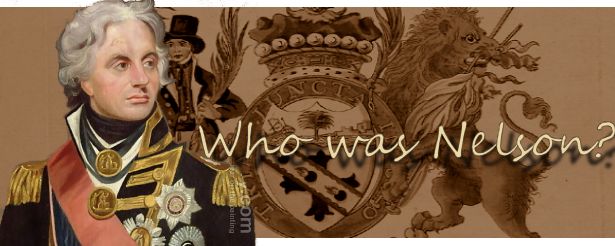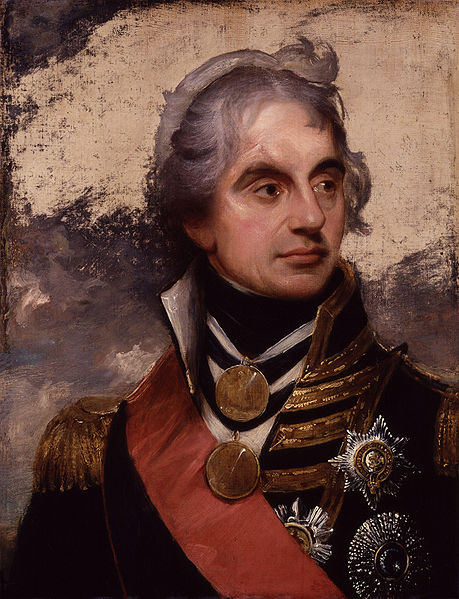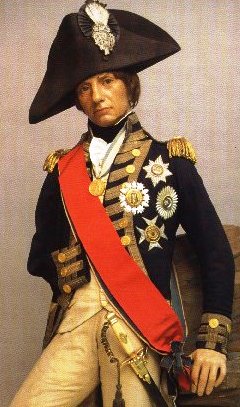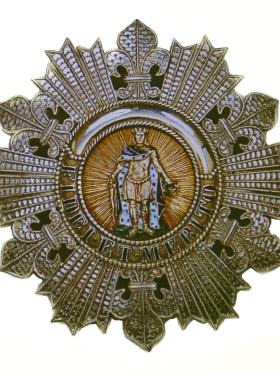

|
|
|||

If you have ever been to London, chances are you will have passed Trafalgar
Square, at the heart of which stands Nelson's Column, a 185-tall monument at
the top of which is perched a statue of Britain's most famous Admiral.
He stands looking over the Admiralty, from whom he took his orders; the
Thames, up which his funeral procession sailed; and, far beyond, Portsmouth,
where his famous ship HMS Victory
still resides. But who was he, and what did he do to deserve such a
memorial? Here is a summary of the essential things you need to know.
(You can also refer to the
![]() Timeline
for a chronological summary of his life and career.)
Timeline
for a chronological summary of his life and career.)
 Lord
Horatio Nelson
Lord
Horatio Nelson
(for a more comprehensive chronology of Nelson's life, please see the Timeline page)
Nelson joined the navy aged 12, thanks to his uncle, Captain Maurice Suckling of the Raisonnable.
American War of Independence (April 1775 - September 1783)
French Revolutionary Wars (April 1792 - March 1802)
The Napoleonic War (May 1803 - November 1815)
This is the full list of all Nelson's titles, as inscribed on his tomb and read out at his funeral:
Lord Horatio Nelson
Viscount and Baron Nelson, of the Nile and of Burnham Thorpe in the County of Norfolk;
Baron Nelson of the Nile and of Hilborough in the said county;
Knight of the Most Honourable Order of the Bath;
Vice Admiral of the White Squadron of the Fleet;
Commander in Chief of His Majesty's Ships and Vessels in the Mediterranean;
Duke of Bronte in the Kingdom of Sicily;
Knight Grand Cross of the Sicilian Order of St Ferdinand and of Merit;
Member of the Ottoman Order of the Crescent;
Knight Grand Commander of the Order of St Joachim.
 As
well as these titles, Nelson was awarded honours which he wore proudly
emblazoned on his dress uniform (the flashy one worn for portraits and
formal occasions), and of which he had sequined replicas sewn onto his
working uniforms, such as the one he was wearing at Trafalgar. Three of
them were awarded by foreign powers, so he had to obtain permission from the
British King to be allowed to wear them. He was deeply grateful and
proud of these honours, particularly because he often felt the British
Government hadn't done enough to reward him for his services. But the
stars, and particularly the chelengk in his hat, were very large and flashy,
and he was often ridiculed and accused of vanity - a famous caricature shows
him as a little man weighed down by large badges and an oversized chelengk,
and Earl St Vincent once described him as "strung with ribbons, medals etc
and yet pretended that he wished to avoid the honours & ceremonies he
everywhere met with upon the Road."
As
well as these titles, Nelson was awarded honours which he wore proudly
emblazoned on his dress uniform (the flashy one worn for portraits and
formal occasions), and of which he had sequined replicas sewn onto his
working uniforms, such as the one he was wearing at Trafalgar. Three of
them were awarded by foreign powers, so he had to obtain permission from the
British King to be allowed to wear them. He was deeply grateful and
proud of these honours, particularly because he often felt the British
Government hadn't done enough to reward him for his services. But the
stars, and particularly the chelengk in his hat, were very large and flashy,
and he was often ridiculed and accused of vanity - a famous caricature shows
him as a little man weighed down by large badges and an oversized chelengk,
and Earl St Vincent once described him as "strung with ribbons, medals etc
and yet pretended that he wished to avoid the honours & ceremonies he
everywhere met with upon the Road."
The waxwork effigy of Nelson in Westminster Abbey (left) is said to be an extremely realistic likeness, as the artist (Catherine Anders) had known and sculpted an image of Nelson before his death. Along with the medals around his neck, the four stars can be seen embroidered onto his coat, and the chelengk on his hat. From the top, clockwise:
Knight Companion of the British Order of the Bath
 Nelson
was awarded the Order of the Bath on the 27th May 1797, after the
Battle of Cape St
Vincent. He knew that he would likely be awarded a baronetcy, but
Nelson was concerned because it was a hereditary honour that would pass to
his heirs, and he didn't possess a great fortune to pass along with it.
For that reason (and also because he craved public recognition, which the
bright red sash and shiny star would certainly bring), he requested an
honour which would 'die with the possessor', and so he was granted a
Knighthood of the Order of the Bath.
Nelson
was awarded the Order of the Bath on the 27th May 1797, after the
Battle of Cape St
Vincent. He knew that he would likely be awarded a baronetcy, but
Nelson was concerned because it was a hereditary honour that would pass to
his heirs, and he didn't possess a great fortune to pass along with it.
For that reason (and also because he craved public recognition, which the
bright red sash and shiny star would certainly bring), he requested an
honour which would 'die with the possessor', and so he was granted a
Knighthood of the Order of the Bath.
The name of the Order of the Bath originates from medieval times, when the ritual conferring a knighthood required the person to cleanse themselves by fasting, praying and washing. Over time, however, the rituals gradually fell into disuse. The Order was revived by George I in 1725, as an elite knighthood comprised of the Sovereign, the Great Master, and 36 Knights Companion, and was awarded to officers of the armed services who deserved special recognition.
Fun fact: The motto of the Order of the Bath is 'Tria Juncta in Uno' which means 'Three Joined in One'. Nelson, Emma and William Hamilton (who was also a knight of the Order of the Bath) used that motto as an in-joke to refer to their arrangement when they were all living together quite happily.
Knight of the Ottoman Order of the Crescent
After
the Battle of the Nile, Sultan Selim III of the Ottoman Empire (now Turkey,
and which Egypt was then part of)
wanted to reward Nelson for the victory, by giving him a chivalric honour.
However, all the ones in existence at that time in his country could only be
given to Muslims, and Nelson was of course Christian. So in August
1799, the Sultan solved the problem by creating the Order of the Crescent
especially for him, and Nelson was its first knight. It was later
awarded to several other British army and navy officers who achieved success
against Napoleon's forces in the Eastern Mediterranean. He also
awarded Nelson with the chelengk - see below.
Perhaps because it had been created especially for him, Nelson was extremely proud of this honour. He wasn't given official permission by the British king to wear it until March 1802, but he used the title after his name after the Battle of Copenhagen in April 1801.
Like all his honours, a replica was sewn onto all of Nelson's coats, but it was upside down! The star was supposed to be to the right of the crescent, but on his Trafalgar coat and the one on his Westminster Abbey waxwork, it can be seen on the left.
Knight Grand Commander of the Order of St Joachim
 The
Order of St Joachim was created in 1755, with its first Grand Master being
Prince Christian Franz, in the German duchy of Saxe-Coburg-Saalfeld.
It's a charitable Order, and significantly, embraced both Catholic and
Protestant members at a time when religion was a cause of great violence in
Europe and other chivalric orders would be on one side or the other.
The
Order of St Joachim was created in 1755, with its first Grand Master being
Prince Christian Franz, in the German duchy of Saxe-Coburg-Saalfeld.
It's a charitable Order, and significantly, embraced both Catholic and
Protestant members at a time when religion was a cause of great violence in
Europe and other chivalric orders would be on one side or the other.
Nelson was unanimously voted to have the honour conferred upon him on the 14th September 1801, as a reward for the Battle of the Nile. The Grand Master of the Order, Count Ferdinand Karl III, had seen his father (the previous Grand Master) have his lands confiscated and then taken prisoner by Napoleon. So he had a particular special reason for wishing to confer such an honour upon the British admiral who had handed Napoleon such a crushing defeat.
The king granted Nelson permission to wear the insignia in July 1802, and it meant a lot to Nelson to be able to do so.
Knight Grand Cross of the Sicilian Order of St Ferdinand and of Merit
 After
the Battle of the Nile in 1798, Nelson stayed at Naples with the Hamiltons,
and became something of an adviser to the royal family of the Kingdom of the
Two Sicilies. When the French invaded Naples, Nelson helped the royal
family and court escape to Palermo, and then he was instrumental in taking
Naples back.
After
the Battle of the Nile in 1798, Nelson stayed at Naples with the Hamiltons,
and became something of an adviser to the royal family of the Kingdom of the
Two Sicilies. When the French invaded Naples, Nelson helped the royal
family and court escape to Palermo, and then he was instrumental in taking
Naples back.
King Ferdinand IV wanted to reward Nelson for his efforts, but the existing Neapolitan chivalric order, the Order of St Januarius, could only be given to catholics. So, in the same way as the Turkish Sultan created the Order of the Crescent, Ferdinand created the Order of St Ferdinand and of Merit, named after his ancestor Ferdinand the Great, King of Castile, which could be given to someone from any religion. The Order was created in April 1800, to reward people for 'extraordinary and important services' and for showing 'extraordinary proofs of loyalty and attachment to our royal person and to the monarchy'. After his actions in Naples, which damaged his reputation in England, no one could argue that Nelson's loyalty to the King of the Two Sicilies was anything other than extraordinary.
 Not
content simply with creating a new chivalric order with which to honour
Nelson, Sultan Selim III of the Ottoman Empire also sent him a gift of a
chelengk. Originally, the word chelengk was defined as 'a bird feather
which one attaches to one's cap as a sign of bravery', and it was awarded
for miltary merit. Nelson was the first non-Ottoman to receive one,
and he wore it in his Admiral's dress hat.
Not
content simply with creating a new chivalric order with which to honour
Nelson, Sultan Selim III of the Ottoman Empire also sent him a gift of a
chelengk. Originally, the word chelengk was defined as 'a bird feather
which one attaches to one's cap as a sign of bravery', and it was awarded
for miltary merit. Nelson was the first non-Ottoman to receive one,
and he wore it in his Admiral's dress hat.
The chelengk was an aigrette made of 300 diamonds in the design of a flower with 13 rays fanning out from it, each ray representing one of the French ships captured or destroyed at the Battle of the Nile. It contained a tiny hidden clockwork mechanism which could make the large centre diamond rotate so that it would sparkle as it caught the light.
Though a chelengk of some variety was a fairly common reward among the Ottomans, the one made specially for Nelson was exceptional in that it was worth as much as one decorating the turban of the sultan himself.
Sources:
The Official Website of the British Monarchy
www.borbone-due-sicilie.org/the-royal-orders/st-ferdinand-and-of-merit/index.html
Ottoman Orders and Decorations
Copright Vicki Singleton 2013.